汉英散文翻译鉴赏剖析剖析共18页
- 格式:ppt
- 大小:2.61 MB
- 文档页数:18
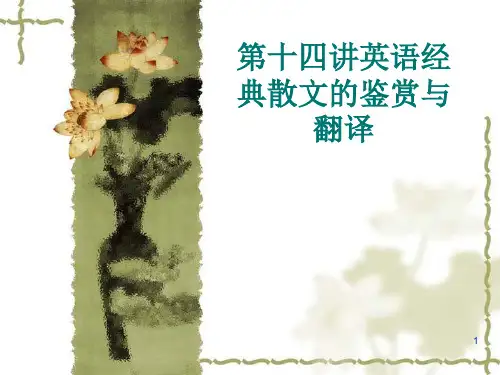
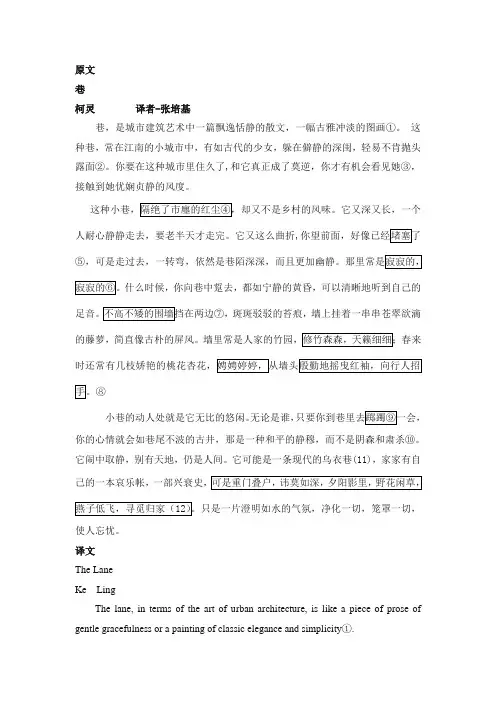
原文巷柯灵译者-张培基巷,是城市建筑艺术中一篇飘逸恬静的散文,一幅古雅冲淡的图画①。
这种巷,常在江南的小城市中,有如古代的少女,躲在僻静的深闺,轻易不肯抛头露面②。
你要在这种城市里住久了,和它真正成了莫逆,你才有机会看见她③,接触到她优娴贞静的风度。
人耐心静静走去,要老半天才走完。
它又这么曲折,什么时候,你向巷中踅去,都如宁静的黄昏,可以清晰地听到自己的斑斑驳驳的苔痕,墙上挂着一串串苍翠欲滴小巷的动人处就是它无比的悠闲。
无论是谁,你的心情就会如巷尾不波的古井,那是一种和平的静穆,而不是阴森和肃杀⑩。
它闹中取静,别有天地,仍是人间。
它可能是一条现代的乌衣巷(11),家家有自己的一本哀乐帐,使人忘忧。
译文The LaneKe LingThe lane, in terms of the art of urban architecture, is like a piece of prose of gentle gracefulness or a painting of classic elegance and simplicity①.maiden of ancient times hidden away in a secluded boudoir, is reluctant to make itslong time.③taste of the countryside at all. It is long and deep, so it will take you a long while to walk patiently and quietly through it from end to end. It is also so winding that it⑤when you look far ahead, but if you keep walking until you take a turning, you’ll find it again lying endless and still more quiet. There is nothing but stillness there⑥. At any hour of day, you can even distinctly hear in the, which, moss-covered and hung with clusters of fresh green wisteria, look almost like screens of primitive simplicity. Inside the walls are residents’ gardenswith In spring,beautiful peach and apricot blossoms atop the ⑧waving their red sleeves, will sway hospitably to beckon the pedestrians.The charm of the lane lies in its absolute serenity. No matter who you are, if youin the lane for a while⑨, your mind will become as unruffled as theancient well at the end of the lane. There you a kind of peaceful calmness rather than gloomy sternness⑩. There reigns peace and quiet in the midst of(11)where each family, secluded behind closed doors, has its own(12)The all-pervading and all-purifying atmosphere of water-like placidness makes one forget all cares and worries.评析:1、明喻(simile).中文中"巷,是…"与英文中"like"相对应。
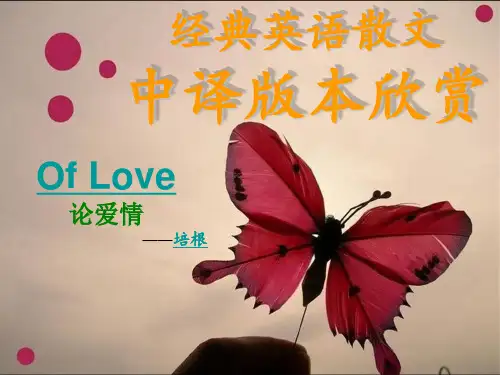

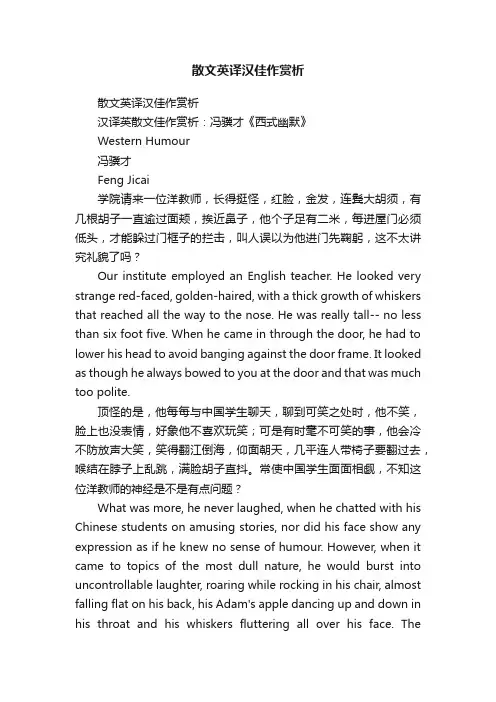
散文英译汉佳作赏析散文英译汉佳作赏析汉译英散文佳作赏析:冯骥才《西式幽默》Western Humour冯骥才Feng Jicai学院请来一位洋教师,长得挺怪,红脸,金发,连鬓大胡须,有几根胡子一直逾过面颊,挨近鼻子,他个子足有二米,每迸屋门必须低头,才能躲过门框子的拦击,叫人误以为他进门先鞠躬,这不太讲究礼貌了吗?Our institute employed an English teacher. He looked very strange red-faced, golden-haired, with a thick growth of whiskers that reached all the way to the nose. He was really tall-- no less than six foot five. When he came in through the door, he had to lower his head to avoid banging against the door frame. It looked as though he always bowed to you at the door and that was much too polite.顶怪的是,他每每与中国学生聊天,聊到可笑之处时,他不笑,脸上也没表情,好象他不喜欢玩笑;可是有时毫不可笑的事,他会冷不防放声大笑,笑得翻江倒海,仰面朝天,几平连人带椅子要翻过去,喉结在脖子上乱跳,满脸胡子直抖。
常使中国学生面面相觑,不知这位洋教师的神经是不是有点问题?What was more, he never laughed, when he chatted with his Chinese students on amusing stories, nor did his face show any expression as if he knew no sense of humour. However, when it came to topics of the most dull nature, he would burst into uncontrollable laughter, roaring while rocking in his chair, almost falling flat on his back, his Adam's apple dancing up and down in his throat and his whiskers fluttering all over his face. Thestudents would then look at each other, wondering if he was in his right mind.一天,洋教师出题,考察学生们用洋文作文的水准,题目极简单,随便议论议论校园内的一事一物,褒贬皆可。

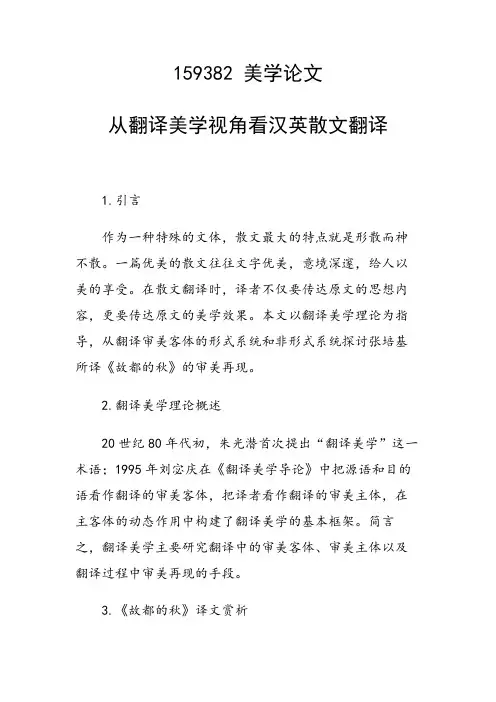
159382 美学论文从翻译美学视角看汉英散文翻译1.引言作为一种特殊的文体,散文最大的特点就是形散而神不散。
一篇优美的散文往往文字优美,意境深邃,给人以美的享受。
在散文翻译时,译者不仅要传达原文的思想内容,更要传达原文的美学效果。
本文以翻译美学理论为指导,从翻译审美客体的形式系统和非形式系统探讨张培基所译《故都的秋》的审美再现。
2.翻译美学理论概述20世纪80年代初,朱光潜首次提出“翻译美学”这一术语;1995年刘宓庆在《翻译美学导论》中把源语和目的语看作翻译的审美客体,把译者看作翻译的审美主体,在主客体的动态作用中构建了翻译美学的基本框架。
简言之,翻译美学主要研究翻译中的审美客体、审美主体以及翻译过程中审美再现的手段。
3.《故都的秋》译文赏析3.1 形式系统的审美再现音韵之美。
音韵之美体现在韵律和节奏上。
散文对音韵的使用极广泛,不仅可以加强语言的音乐美,还增加了人们对语言艺术欣赏的情趣。
翻译时译者应充分发掘译语的语言优势,通过头韵、内韵、尾韵等的巧妙运用实现音韵美再现。
例:最好,还要在牵牛花底教长着几根疏疏落落的尖细且长的秋草,使作陪衬。
It will be most desirable to have them set of by some tall thin grass planted underneath here and there.原文中叠词“疏疏落落”的使用给人以音韵上的美感,但是翻译时却很难不损其美。
译者此处联想到英语中的押尾韵,将其译成“here and there”。
将汉语的叠词之美恰到好处地转移到英语的尾韵上,使译文达到视觉美与听觉美的统一。
遣词之美。
词汇层的审美信息主要体现在措词上。
作者通常会花费大量时间去选词。
精当的选词能给散文的美感和质感很大的提升,提高散文的档次。
因此,在翻译过程中译者同样需要精挑细选,以求尽可能地保留原作的韵味。
例:我不远千里,要从杭州赶上青岛,更要从青岛赶上北平来的理由,也不过想饱尝一尝这秋,这故都的秋味。
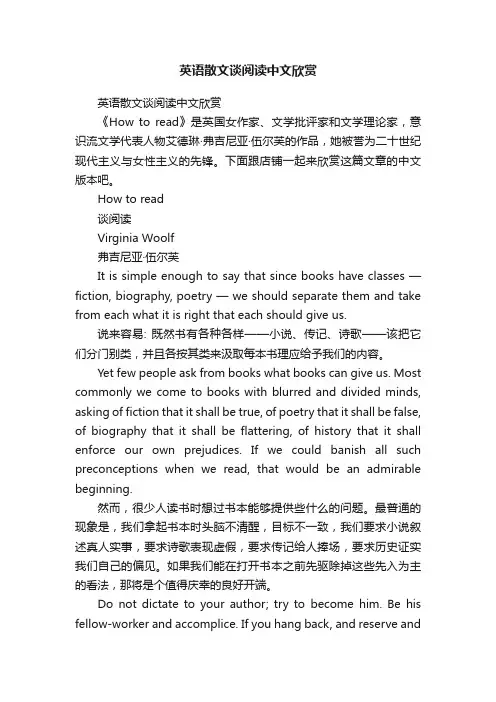
英语散文谈阅读中文欣赏英语散文谈阅读中文欣赏《How to read》是英国女作家、文学批评家和文学理论家,意识流文学代表人物艾德琳·弗吉尼亚·伍尔芙的作品,她被誉为二十世纪现代主义与女性主义的先锋。
下面跟店铺一起来欣赏这篇文章的中文版本吧。
How to read谈阅读Virginia Woolf弗吉尼亚·伍尔芙It is simple enough to say that since books have classes —fiction, biography, poetry — we should separate them and take from each what it is right that each should give us.说来容易: 既然书有各种各样——小说、传记、诗歌——该把它们分门别类,并且各按其类来汲取每本书理应给予我们的内容。
Yet few people ask from books what books can give us. Most commonly we come to books with blurred and divided minds, asking of fiction that it shall be true, of poetry that it shall be false, of biography that it shall be flattering, of history that it shall enforce our own prejudices. If we could banish all such preconceptions when we read, that would be an admirable beginning.然而,很少人读书时想过书本能够提供些什么的问题。
最普通的现象是,我们拿起书本时头脑不清醒,目标不一致,我们要求小说叙述真人实事,要求诗歌表现虚假,要求传记给人捧场,要求历史证实我们自己的偏见。
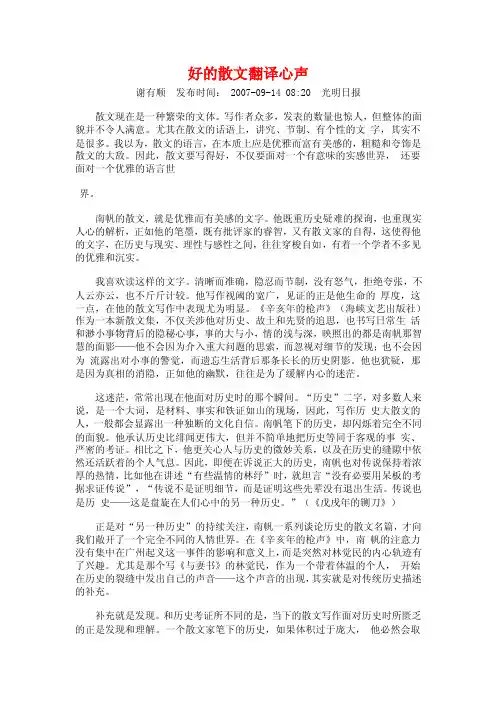
好的散文翻译心声谢有顺发布时间: 2007-09-14 08:20 光明日报散文现在是一种繁荣的文体。
写作者众多,发表的数量也惊人,但整体的面貌并不令人满意。
尤其在散文的话语上,讲究、节制、有个性的文字,其实不是很多。
我以为,散文的语言,在本质上应是优雅而富有美感的,粗糙和夸饰是散文的大敌。
因此,散文要写得好,不仅要面对一个有意味的实感世界,还要面对一个优雅的语言世界。
南帆的散文,就是优雅而有美感的文字。
他既重历史疑难的探询,也重现实人心的解析,正如他的笔墨,既有批评家的睿智,又有散文家的自得,这使得他的文字,在历史与现实、理性与感性之间,往往穿梭自如,有着一个学者不多见的优雅和沉实。
我喜欢读这样的文字。
清晰而准确,隐忍而节制,没有怒气,拒绝夸张,不人云亦云,也不斤斤计较。
他写作视阈的宽广,见证的正是他生命的厚度,这一点,在他的散文写作中表现尤为明显。
《辛亥年的枪声》(海峡文艺出版社)作为一本新散文集,不仅关涉他对历史、故土和先贤的追思,也书写日常生活和渺小事物背后的隐秘心事,事的大与小,情的浅与深,映照出的都是南帆那智慧的面影——他不会因为介入重大问题的思索,而忽视对细节的发现;也不会因为流露出对小事的警觉,而遗忘生活背后那条长长的历史阴影。
他也犹疑,那是因为真相的消隐,正如他的幽默,往往是为了缓解内心的迷茫。
这迷茫,常常出现在他面对历史时的那个瞬间。
“历史”二字,对多数人来说,是一个大词,是材料、事实和铁证如山的现场,因此,写作历史大散文的人,一般都会显露出一种独断的文化自信。
南帆笔下的历史,却闪烁着完全不同的面貌。
他承认历史比绯闻更伟大,但并不简单地把历史等同于客观的事实、严密的考证。
相比之下,他更关心人与历史的微妙关系,以及在历史的缝隙中依然还活跃着的个人气息。
因此,即便在诉说正大的历史,南帆也对传说保持着浓厚的热情,比如他在讲述“有些温情的林纾”时,就坦言“没有必要用呆板的考据求证传说”,“传说不是证明细节,而是证明这些先辈没有退出生活。
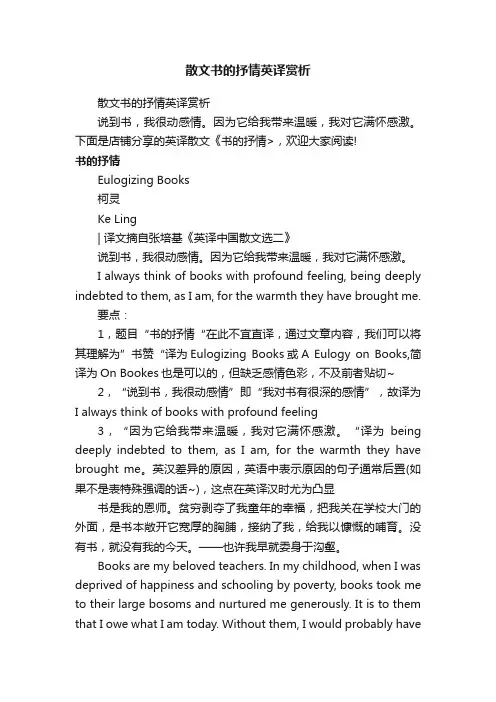
散文书的抒情英译赏析散文书的抒情英译赏析说到书,我很动感情。
因为它给我带来温暖,我对它满怀感激。
下面是店铺分享的英译散文《书的抒情>,欢迎大家阅读!书的抒情Eulogizing Books柯灵Ke Ling| 译文摘自张培基《英译中国散文选二》说到书,我很动感情。
因为它给我带来温暖,我对它满怀感激。
I always think of books with profound feeling, being deeply indebted to them, as I am, for the warmth they have brought me.要点:1,题目“书的抒情“在此不宜直译,通过文章内容,我们可以将其理解为”书赞“译为Eulogizing Books或A Eulogy on Books,简译为On Bookes也是可以的,但缺乏感情色彩,不及前者贴切~ 2,“说到书,我很动感情”即“我对书有很深的感情”,故译为I always think of books with profound feeling3,“因为它给我带来温暖,我对它满怀感激。
“译为being deeply indebted to them, as I am, for the warmth they have brought me。
英汉差异的原因,英语中表示原因的句子通常后置(如果不是表特殊强调的话~),这点在英译汉时尤为凸显书是我的恩师。
贫穷剥夺了我童年的幸福,把我关在学校大门的外面,是书本敞开它宽厚的胸脯,接纳了我,给我以慷慨的哺育。
没有书,就没有我的今天。
——也许我早就委身于沟壑。
Books are my beloved teachers. In my childhood, when I was deprived of happiness and schooling by poverty, books took me to their large bosoms and nurtured me generously. It is to them that I owe what I am today. Without them, I would probably haveended up in abject misery long ago.要点:1,”贫穷剥夺了我童年的幸福,把我关在学校大门的外面,是书本敞开它宽厚的胸脯,接纳了我,给我以慷慨的哺育”注意本句在合译时,,将“贫穷剥夺了我童年的幸福,把我关在学校大门的外面”译为时间状语从句,取“书本”作主语,这种译法很巧妙地将分句意思串联在了一起,也值得我们学习和借鉴2,“剥夺了我童年的幸福,把我关在学校大门的外面”译者将其视为一个意思,即“剥夺了我童年的幸福和受教育的机会”,进行合译,译为was deprived of happiness and schooling by poverty 3,“沟壑”本指“溪谷”山沟,常引申指“野死之处”,因此本句意为“死无葬身之处”,译为would probably have ended up in abject misery,意思是“结局悲惨”书是我的良友。
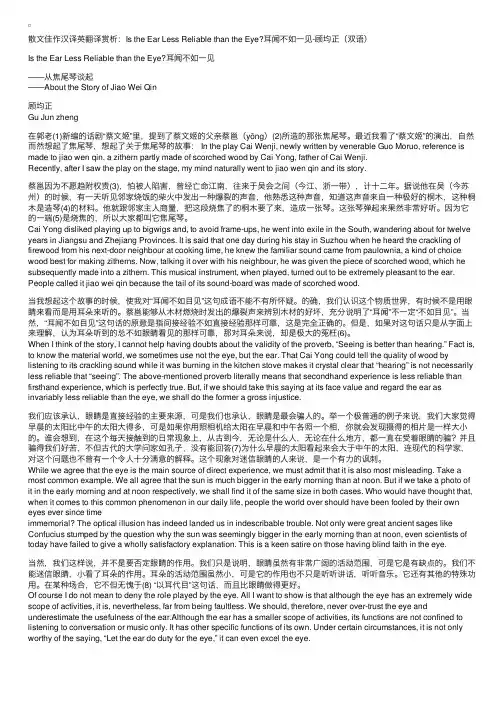
散⽂佳作汉译英翻译赏析:Is the Ear Less Reliable than the Eye?⽿闻不如⼀见-顾均正(双语)Is the Ear Less Reliable than the Eye?⽿闻不如⼀见——从焦尾琴谈起——About the Story of Jiao Wei Qin顾均正Gu Jun zheng在郭⽼(1)新编的话剧“蔡⽂姬”⾥,提到了蔡⽂姬的⽗亲蔡邕(yōng)(2)所造的那张焦尾琴。
最近我看了“蔡⽂姬”的演出,⾃然⽽然想起了焦尾琴,想起了关于焦尾琴的故事: In the play Cai Wenji, newly written by venerable Guo Moruo, reference is made to jiao wen qin, a zithern partly made of scorched wood by Cai Yong, father of Cai Wenji.Recently, after I saw the play on the stage, my mind naturally went to jiao wen qin and its story.蔡邕因为不愿趋附权贵(3),怕被⼈陷害,曾经亡命江南,往来于吴会之间(今江、浙⼀带),计⼗⼆年。
据说他在吴(今苏州)的时候,有⼀天听见邻家烧饭的柴⽕中发出⼀种爆裂的声⾳,他熟悉这种声⾳,知道这声⾳来⾃⼀种极好的桐⽊,这种桐⽊是造琴(4)的材料。
他就跟邻家主⼈商量,把这段烧焦了的桐⽊要了来,造成⼀张琴。
这张琴弹起来果然⾮常好听。
因为它的⼀端(5)是烧焦的,所以⼤家都叫它焦尾琴。
Cai Yong disliked playing up to bigwigs and, to avoid frame-ups, he went into exile in the South, wandering about for twelve years in Jiangsu and Zhejiang Provinces. It is said that one day during his stay in Suzhou when he heard the crackling of firewood from his next-door neighbour at cooking time, he knew the familiar sound came from paulownia, a kind of choice wood best for making zitherns. Now, talking it over with his neighbour, he was given the piece of scorched wood, which he subsequently made into a zithern. This musical instrument, when played, turned out to be extremely pleasant to the ear. People called it jiao wei qin because the tail of its sound-board was made of scorched wood.当我想起这个故事的时候,使我对“⽿闻不如⽬见”这句成语不能不有所怀疑。
汉英散文翻译但是,朔方的雪花纷飞之后,却永远如粉,如沙,他们决不粘连,撒在屋上,地上,枯草上,就是这样。
屋上的雪是早就有消化了的,因为屋里居人的火的温热。
别的,在晴天之下,旋风忽来,便蓬勃地奋飞,在日光中灿灿地生光,如包藏火焰的大雾,旋转而且升腾,弥漫太空,使太空旋转而且升腾地闪烁。
(“雪”,摘自鲁迅《野草》)But the snowflakes that fall in the north remain to the last like powder or sand never hold together, wether scattered on roofs, the ground or the withered grass. The warmth from the stoves inside has melted some of the snow on the roofs. As for the rest, when a whirlwind springs up under a clear sky, it flies up wildly, glittering in the sunlight like thick mist around a flame, revolving and rising till fills the sky, and the whole sky glitters as it whirls and rises.几个女人羞红着脸告辞出来,摇开靠在岸边上的小船.现在已经快到晌午了,万里无云,可是因为在水上,还有些凉风.这风从南面吹过来,从稻秧上苇尖吹过来,水面没有一只船,水象无边的跳荡的水银.Shamed-faced and blushing, the women took their leave and rowed off again. It was nearly noon, without a cloud in the sky, but on the river was a breeze from the paddy fields and rushed in the south. There was the only boat afloat on the endless expanse of water like rippling quicksilver.几个女人有点失望, 也有些伤心,各人在心里骂着自己的狠心贼.可是青年人,永远朝着愉快的事情想,女人们尤其容易忘记那些不痛快.不久,她们就又说笑起来了.“你看说走就走了。